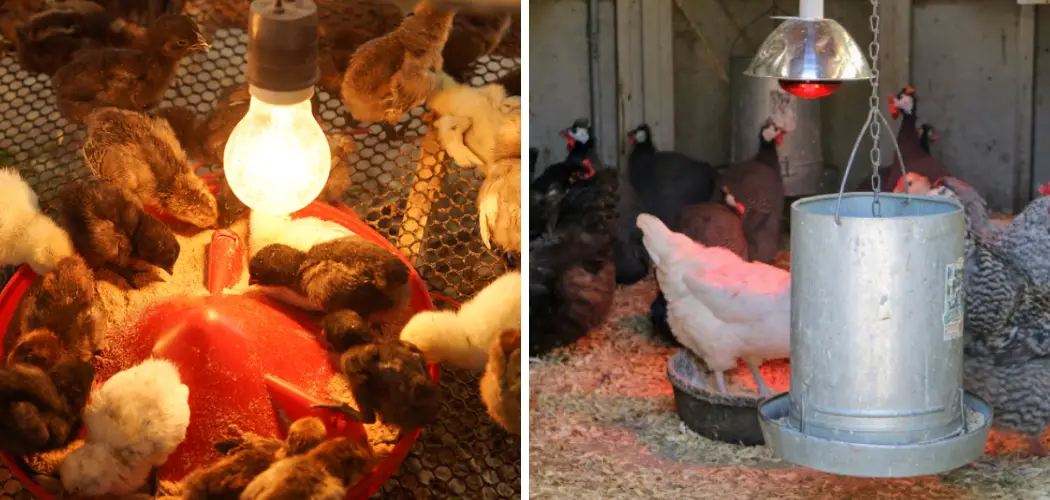Maintaining a warm and comfortable environment is crucial when raising chickens. A cold and damp chicken coop can lead to health problems and decreased egg production for your flock.
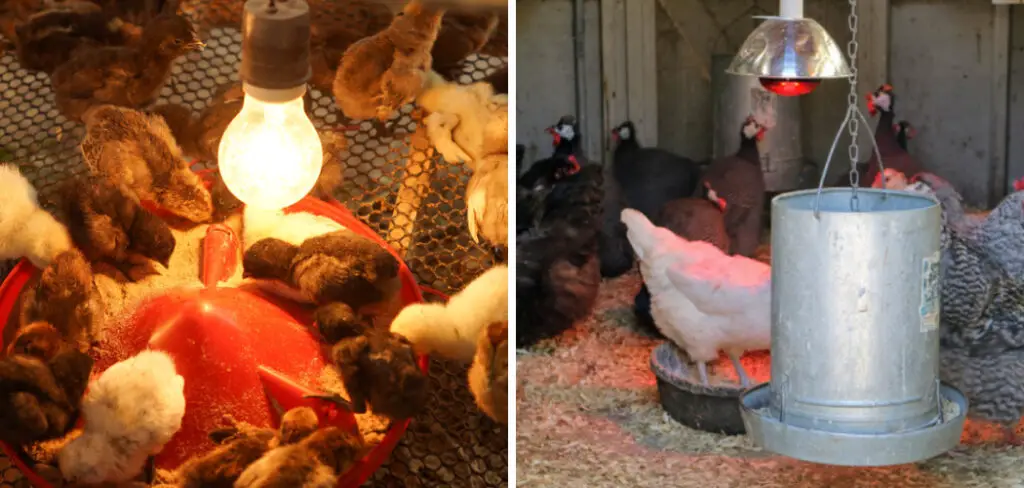
Chicken coops are essential for keeping chickens safe, secure, and warm. During the winter seasons, it is important to maintain a warm temperature inside the chicken coop in order to keep the chickens healthy and happy. In this guide, we will discuss different ways how to heat a chicken coop effectively.
Necessary Items
Before getting into the methods of heating a chicken coop, it is important to have some necessary items on hand. These include:
- A reliable heat source such as a heater or heat lamp
- Extension cords and power outlets for the heat source
- Insulation materials such as straw or hay
- Thermometer to monitor temperature inside the coop
It is important to note that the heat source should be placed high enough so that it doesn’t come in direct contact with the chickens and cause any harm.
9 Things to Know Before You Start
1) The Ideal Temperature
The ideal temperature for a chicken coop is between 50-60 degrees Fahrenheit. This ensures that the chickens are warm enough without being too hot. It is important to keep in mind that chickens can withstand colder temperatures than humans, so it is not necessary to maintain a high indoor temperature.
2) Don’t Overheat
While it may be tempting to turn up the heat during extremely cold weather, it is important not to overheat the chicken coop. Overheating can cause health problems for chickens, such as respiratory issues and feather loss.
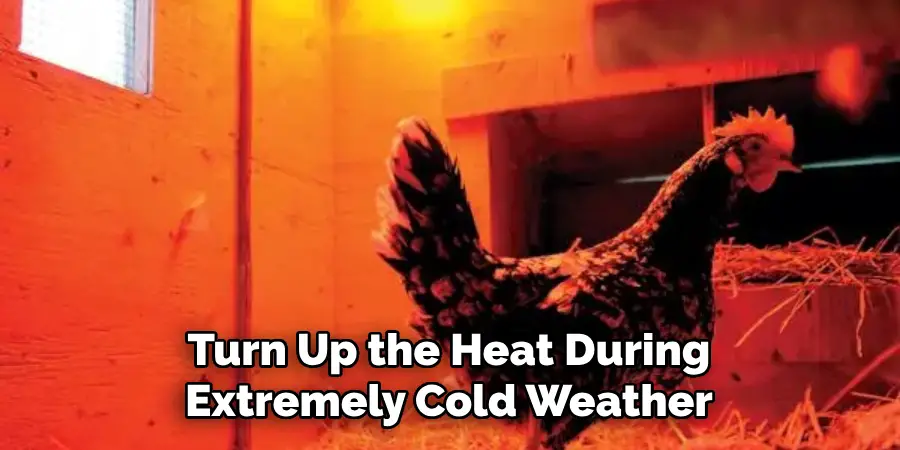
3) Insulate Your Coop
Insulating your chicken coop is essential in maintaining a warm environment. This can be done by filling any cracks or holes with insulation materials such as straw or hay. It is also important to insulate the walls and roof of the coop.
4) Ventilation is Key
Proper ventilation is crucial in keeping a chicken coop warm. This allows for fresh air to circulate and prevents any moisture from building up, which can lead to health issues for chickens. If using a heat source, make sure there is enough ventilation to prevent carbon monoxide buildup.
5) Prepare for Power Outages
During winter storms or power outages, it is essential to have a backup plan for heating the chicken coop. This can include alternative heat sources such as heated water bowls or even bringing the chickens inside if necessary.
6) Check for Fire Hazards
When using a heat source, make sure to regularly check for any potential fire hazards, such as frayed wires or overheating equipment. It is also essential to keep the heat source away from any flammable materials.
7) Monitor Temperature Changes
It is important to regularly monitor the temperature inside the chicken coop, especially when using a heat source. A thermometer can be used to keep track of any significant temperature changes.
8) Consider the Size of Your Coop
The size of your coop will also determine the heating method you use. Smaller coops may only require a heat lamp, while larger coops may need additional sources of heat, such as a heater or heated floor. It is important to consider the size of your coop when choosing a heating method.
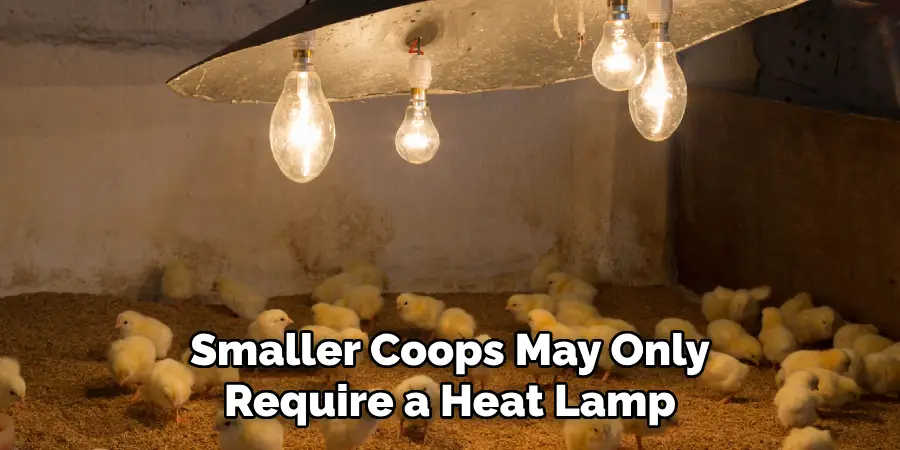
9) Observe Your Chickens
Lastly, it is important to observe your chickens and their behavior. If they are huddling together or showing signs of being too cold, it may be necessary to adjust the heat source or add additional insulation.
By following these tips on how to heat a chicken coop, you can successfully heat a chicken coop and ensure the well-being of your flock during colder months. Remember to regularly check on the temperature and ventilation of the coop and have a backup plan in case of power outages. A warm and comfortable environment will lead to healthier chickens and more productive egg-laying.
12 Methods on How to Heat a Chicken Coop
Method 1: Use a Heat Lamp
A heat lamp is the most common method of heating a chicken coop. It provides direct warmth and can be adjusted to different heights depending on the temperature needed. However, it is important to keep in mind that heat lamps can be fire hazards and should be used with caution.
Method 2: Install a Heater
Installing a heater in the chicken coop is another effective way to maintain a warm environment. There are various types of heaters available, such as infrared, ceramic, or radiant heaters, depending on the size and needs of your coop.
Method 3: Use a Brooder Plate
A brooder plate is a great alternative to heat lamps as it provides warmth from underneath rather than overhead. This mimics the natural warmth that a mother hen would provide for her chicks. Brooder plates are also energy-efficient and safe to use.
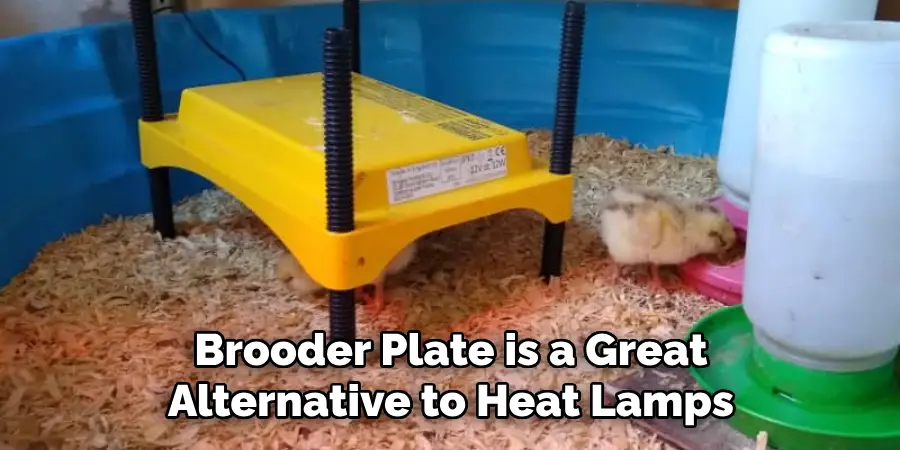
Method 4: Install a Heated Floor
If you have a larger coop, installing a heated floor may be necessary to keep the entire space warm. This method is more expensive, but it provides even heat distribution and allows chickens to roam around comfortably.
Method 5: Use a Heat Tape
Heat tape is a cost-effective option for heating small areas of the coop. It can be placed on perches or in nesting boxes to provide warmth directly where chickens spend most of their time. While it is safe to use, it should be monitored regularly for any potential fire hazards.
Method 6: Invest in a Radiant Heater
Radiant heaters emit infrared heat, which warms objects and animals rather than the air. This makes them an efficient option for heating a chicken coop. However, these heaters should also be used with caution as they can cause burns if touched directly.
Method 7: Utilize Solar Power
Solar-powered heaters are a sustainable and cost-effective option for heating a chicken coop. They use energy from the sun to provide warmth, making them an environmentally-friendly choice. Moreover, they can be used in remote areas without access to electricity.
Method 8: Make Use of Natural Heat Sources
If you live in a mild climate, you may not need to use any artificial heat sources at all. Instead, you can utilize natural heat sources such as the sun and composting materials to keep the coop warm. This method may require some extra planning and preparation, but it can save money and energy in the long run.
Method 9: Use a Heat-Reflective Material
Insulating your coop with heat-reflective materials such as foil or emergency blankets can help retain heat inside the coop. These materials reflect heat back into the space rather than letting it escape through walls or windows.
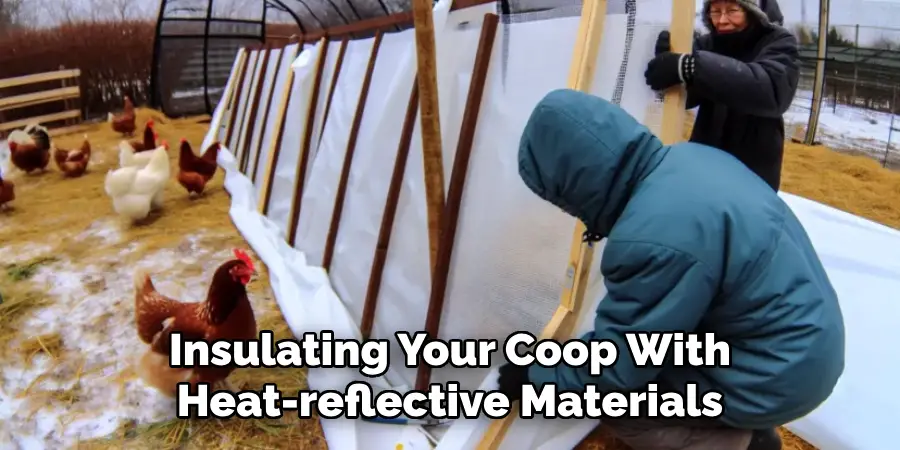
Method 10: Install a Solar Air Heater
Similar to solar-powered heaters, solar air heaters use energy from the sun to warm up air that is then blown into the coop. They are relatively easy to install and can provide consistent heat throughout the day.
Method 11: Consider Using a Gas or Propane Heater
Gas or propane heaters are an option for heating larger coops where other methods may not be sufficient. They are also relatively affordable and can provide consistent heat for extended periods.
Method 12: Bring the Chickens Indoors
In extremely cold weather, it may be necessary to bring chickens inside your home or garage temporarily until temperatures improve. This should only be done as a last resort, as chickens have specific needs and behaviors that may not be suitable for an indoor environment.
Overall, there are many methods available for heating a chicken coop during colder months. It is important to choose the method that best fits your specific needs and take the necessary precautions to ensure the safety and well-being of your flock. Regular monitoring of temperature changes and ventilation is key to maintaining a warm and comfortable environment for your chickens.
8 Things to Avoid When Heating a Chicken Coop
1) Using an Open Flame
Using an open flame as a heat source in a chicken coop is extremely dangerous and should be avoided at all costs. This includes candles, kerosene heaters, or any other potentially fire-hazardous devices.
2) Overcrowding the Coop
While it may be tempting to keep your chickens warm by crowding them inside a smaller space, this can actually be counterproductive. Overcrowding can lead to increased moisture and ammonia buildup in the coop, which can cause health problems for chickens.
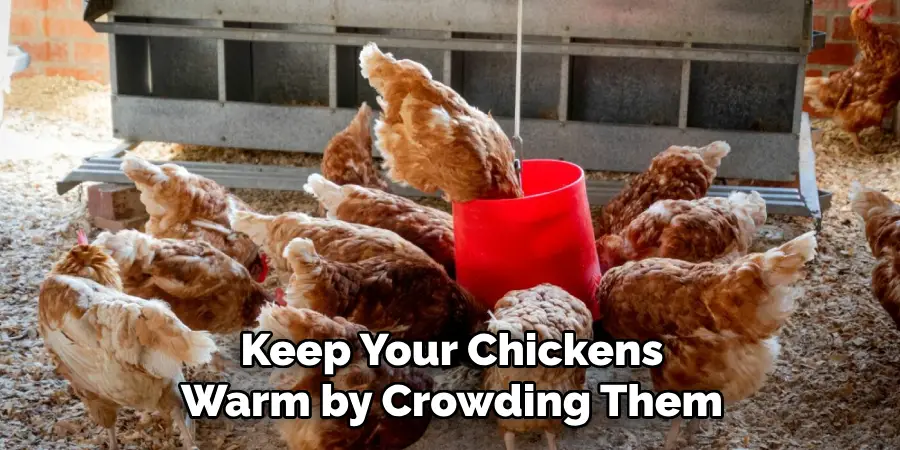
3) Not Providing Proper Ventilation
Proper ventilation is crucial in a chicken coop, especially when using heat sources. Without proper ventilation, ammonia and moisture can build up, causing respiratory issues for chickens and potentially leading to mold growth in the coop.
4) Using A Heat Source That is Too Strong
It may be tempting to use a strong heat source to quickly warm up the coop, but this can be dangerous for both chickens and the structure of the coop. It is important to carefully choose a heat source that is appropriate for the size of your coop and monitor its temperature regularly.
5) Not Monitoring Temperature Changes
Monitoring temperature changes in the coop is crucial to ensure that chickens are not overheating or getting too cold. Failure to do so can lead to health issues for chickens and potential fire hazards if heat sources are not properly managed.
6) Using Uninsulated Heaters
Heaters that are not properly insulated can pose a fire hazard and should be avoided. It is important to choose heaters that have insulation built in or add insulation around them for added safety. If using heat lamps, make sure they are secured and out of reach of chickens.
7) Not Providing Enough Bedding
Bedding not only provides insulation for the coop but also absorbs moisture from droppings. Make sure to provide enough bedding for your chickens to keep them warm and prevent any potential health issues from a damp environment.
8) Neglecting to Consider Chickens’ Natural Behaviors
Chickens have natural behaviors, such as roosting and huddling together for warmth. It is important to consider these behaviors when heating a coop and provide appropriate perches and space for chickens to comfortably roost and gather together for warmth. Neglecting these behaviors can lead to potential stress or health issues for chickens.

Overall, avoiding these mistakes on how to heat a chicken coop and taking necessary precautions can help ensure a safe and warm environment for your chickens during colder months. Proper planning and monitoring are key to effectively heating a chicken coop without compromising the well-being of your flock. So, choose the method that best suits your needs and always prioritize safety when heating your chicken coop.
8 Additional Tips for Keeping Chickens Warm in Winter
1) Use the Deep Litter Method
The deep litter method involves regularly adding layers of dry bedding materials, such as straw or wood shavings, to the floor of the coop. As the materials break down, they generate heat and provide insulation for chickens.
2) Add Insulation to the Coop Walls
Adding insulation to the walls of the coop can help retain heat and keep the interior warm. This is especially helpful if you have a large or poorly insulated coop. So, consider adding insulation to your coop before the winter months.
3) Provide a Coop Heater
If you have a smaller coop, you may want to consider investing in a coop heater specifically designed for chicken coops. These heaters are safe and effective at keeping chickens warm without posing a fire hazard.
4) Install Automatic Door Opener
Installing an automatic door opener can help regulate the temperature in the coop by controlling when chickens go in and out. This can also prevent potential heat loss from constantly opening and closing the coop door.
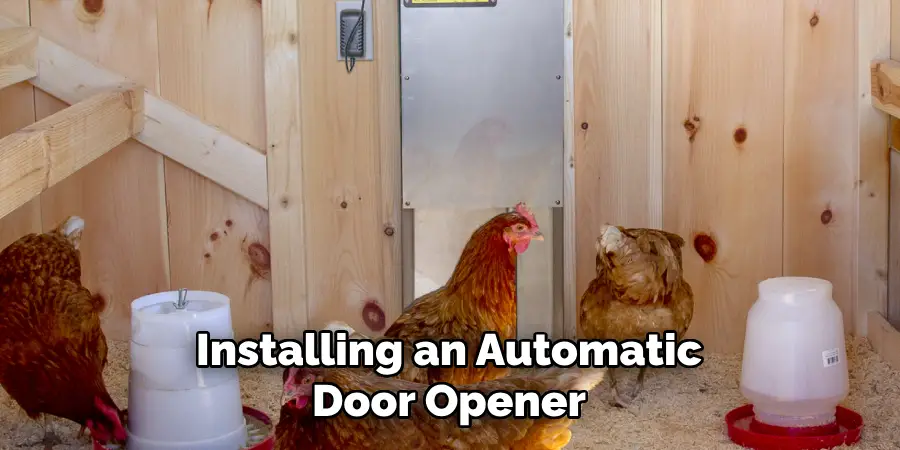
5) Use a Coop Cover or Tarp
Covering part of the coop with a tarp or cover can help block wind and keep heat inside. Make sure to leave enough space for ventilation and check regularly to ensure the tarp is not blocking too much air.
6) Keep Chickens Well-Fed
Chickens need extra energy to stay warm in colder temperatures, so make sure to provide them with enough high-quality feed. Feeding them in the evening can also help keep their bodies warm during the night.
7) Add Heat-Emitting Stones or Bricks
Placing heat-emitting stones or bricks in the coop can help provide a warm spot for chickens to roost on during cold nights. Make sure to place them near perches and monitor their temperature regularly.
8) Consider Using Solar Panels
If you have access to sunlight, consider using solar panels to power a heater or heat lamp in the coop. This can save on electricity costs and provide a sustainable heating option for your chickens.
With these additional tips on how to heat a chicken coop, you can keep your flock warm and comfortable during winter while also being mindful of their natural behaviors and well-being. Remember to always prioritize safety and regularly monitor temperature changes to ensure a happy and healthy flock.
Frequently Asked Questions
Can I Use a Regular Space Heater to Warm My Chicken Coop?
It is not recommended to use a regular space heater in a chicken coop as they can pose fire hazards and may not be designed for the specific needs of chickens. It is best to invest in a heater specifically designed for chicken coops or use alternative methods such as insulation and deep litter.
How Can I Tell If My Chickens Are Too Hot or Cold?
Chickens that are too hot may pant, spread their wings, or hold them away from their body. They may also become lethargic, and experience reduced egg production. Chickens that are too cold may huddle together, have ruffled feathers, or show signs of frostbite on their combs and feet. Regularly monitoring temperature changes in the coop can help prevent these issues.
Is It Necessary to Heat a Chicken Coop?
It is not always necessary to heat a chicken coop as chickens are able to acclimate to colder temperatures. However, in extremely cold climates or for certain breeds of chickens, providing additional heat may be necessary to prevent health issues. It is important to regularly monitor the temperature and behavior of your flock to determine if heating is needed.
How Can I Prevent Fire Hazards When Heating My Chicken Coop?
To prevent fire hazards when heating a chicken coop, choose a heater specifically designed for chicken coops, regularly monitor the temperature, and use proper insulation. Make sure to also regularly check for any frayed wires or damaged heating equipment. In case of a power outage, it is important to have a backup plan in place for keeping your chickens warm without electricity.

Overall, being prepared and taking necessary precautions can help keep your flock safe and warm during colder months. So, consider these tips and make sure to prioritize the well-being of your chickens when heating their coop.
Conclusion
In conclusion, heating a chicken coop during winter can be challenging, but with proper planning and precautions, it can be done safely and effectively. Avoiding common mistakes such as using improper heating methods or neglecting natural chicken behaviors is key to keeping your flock warm and healthy.
Consider the additional tips on how to heat a chicken coop provided in this article, and don’t hesitate to consult with experienced chicken owners for further advice. Remember, a warm and comfortable coop means happy and productive chickens. Stay warm, stay safe, and enjoy your winter with your feathered friends! So, don’t let the cold weather stop you from raising chickens and providing them with a cozy home all year round.
About
Outdoor Fixes is a distinguished figure in the world of Diy design, with a decade of expertise creating innovative and sustainable Diy solutions.
His professional focus lies in merging traditional craftsmanship with modern manufacturing techniques,
fostering designs that are both practical and environmentally conscious. As the author of diy,
outdoorfixes delves into the art and science of outdoorfixes-making, inspiring artisans and industry professionals alike.
Education RMIT University
(Melbourne, Australia) Associate Degree in Design (Outdoor Fixes) Focus on sustainable design, industry-driven projects,
and practical craftsmanship. Gained hands-on experience with traditional and digital manufacturing tools, such as CAD and CNC software.
Nottingham Trent University
(United Kingdom) Bachelor’s in outdoorfixes.com and Product Design (Honors) Specialized in product design with a focus on blending creativity with production
techniques. Participated in industry projects, working with companies like John Lewis and Vitsoe to gain real-world insights.
Publications and Impact
In diy, Outdoor Fixes his insights on indoor design processes, materials, and strategies for efficient production.
His writing bridges the gap between artisan knowledge and modern industry needs, making it a must-read for both budding designers and seasoned professionals.

